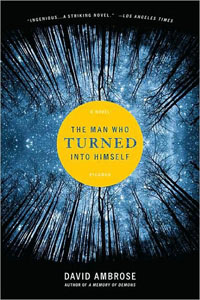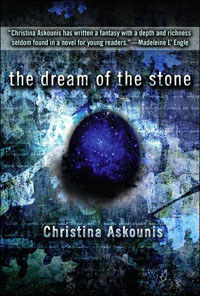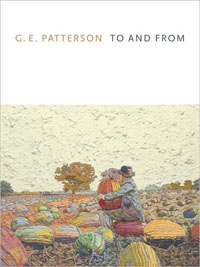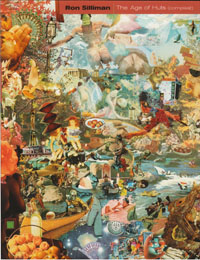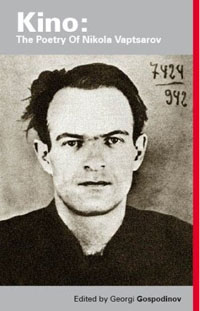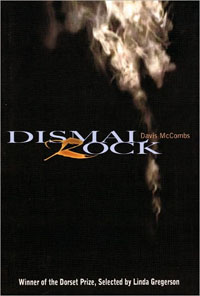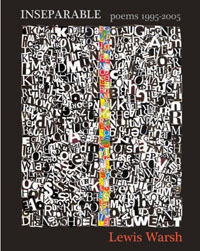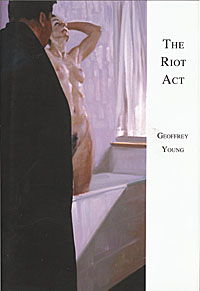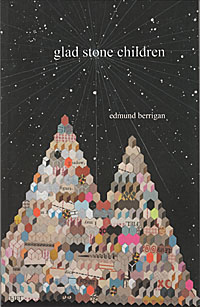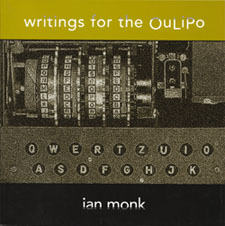Chapbook design, community, and collaboration
by Noah Eli Gordon
I had the opportunity to hear Robert Creeley only once, at Wesleyan University, where he gave one of his last readings. After driving over an hour to attend, arriving five minutes late, being refused admittance, and puttering around until the first wave of students exited the auditorium, I was finally able to listen to him talk during the question and answer session. And talk he did, leading the audience on a sort of rollercoaster ride of language—just as his generosity and connection to poets and poetry yoked together generational and aesthetic divisions, so too was he able to use syntax as an improvisatory shaper and chiseler of thought as it began to find location and form within his sentences.
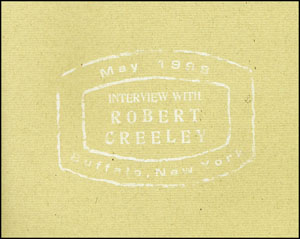
Although there is an abundance of available prose, interviews, and even recordings of Creeley, nothing really captures the drama of performance and conversation, with their attendant hand gestures, stammering and hesitations in speech, and other paratextual moments imbued with meaning. Luckily, some things can come close. Such is the case with the latest chapbook from Hooke Press: Interview with Robert Creeley features a transcription of an interview conducted by Brent Cunningham in May of 1998. In his introduction, Cunningham explains that as a student at SUNY Buffalo in the late ’90s he’d done an independent study with Creeley, where, “Bob would mostly talk and I would mostly listen.” At the semester’s end, Cunningham recorded on “a cheap cassette player” an interview that remained mostly forgotten, until Creeley’s passing sent him back to the original tape, and, eventually to the creation of this chapbook.
Their conversation is fascinating, in that it demonstrates what Cunningham calls “Creeley’s tremendous power of recall and his ability to quote people vividly and possibly even accurately.” There is talk of Pound, Olson, Robert Graves, and Duncan, of numerous professors and scholars, friends, acquaintances, and the conundrums of both domestic and departmental responsibilities. Creeley discusses his admiration for the visionary work of his peers, while admitting his own interest in the particulars, in “reading time and space as an information rather than as a vision.” The interview also contains several pithy takes on a wide range of subjects. Here’s Creeley on myth:
I think myth is mouth. . . that’s what speech is: myth, what’s said. It’s a mouth. There’s not a symbolic mouth. It’s physical.
On poetry and political agency:
I think it’s an activity, not a content.
On the poetry workshop:
Those poems will just be a compromise of every instinct you have.
As an object, this chapbook, which measures 6 ½ x 8 ¼, is a joy to hold. Its wider page layout gives a physical sense of the breadth of its contents. Cunningham, who along with fellow Small Press Distribution employee Neil Alger, founded Hooke Press in late 2005, notes Alger’s design acumen: “I really feel he has a sense of page size and layout that’s unerring and truly impressive. Things like sizing are often neglected when people think about chapbook design, but it’s one of those things that I think powerfully affects how we think of a book-object, just how it fits in the hand and how the size relates to the interior text.”
Among the more stunning moments in the conversation is Creeley’s explanation of what constitutes a “prototypical American writer.” Here, when he says, “What’s interesting about them, variously as a company, is that they all have the necessity of inventing not only themselves but the literature they purport to be fact of,” he’s speaking specifically of Pound, Edward Dahlberg, Dickinson, Moore, H.D., and Williams—and yet, in a sense, this is also a statement about one’s ability to build upon such an invented company, about the necessity of tending the ground one has somehow stumbled upon. Of course, Creeley himself was such a fertile presence and influence for so many writers, with his tenure at Buffalo touching multiple generations of some of the most interesting and active poets now enlarging the field.
As review copies for Rain Taxi’s Chapbook Corner continue to pour in, I’ve noticed a distinct level of quality in the work produced by an expanding matrix of publishers associated with SUNY Buffalo’s Poetics Program. Cunningham notes that, “Hooke was founded almost a decade after I’d left Buffalo. But that year was tremendously significant for me in the sense of challenging and developing my received ideas about poetry, and helping me map out the kinds of work and writers I care about, so in another way just about everything I do with Hooke could be tied back to Buffalo.” And this is evident in the production of the Interview with Robert Creeley chapbook, as it was fellow ex-Buffalo publisher Patrick Durgin, the force behind the now-defunct journal Kenning and the thriving Kenning Editions, who taught Cunningham how to use the Gocco, a Japanese silk-screening device that allows for the cheap production of handmade covers. “It has a somewhat crude aesthetic that we’ve decided to embrace,” notes Cunningham. “For instance, with the Creeley cover we made it look like a passport stamp, so that if the Gocco didn’t print evenly it would just look like we had intended to make it have the unevenness of any passport stamp.” Because economics are always a factor in publishing work that rarely recoups its costs, one has to think creatively. “Like with poetry itself,” says Cunningham, “we feel the limitations and faults of the methods we’re using to design these books can be turned, with some creative re-thinking, into what makes them distinct.”
Speaking of distinction, Cuneiform Press and Atticus/Finch, two of the most impressive publishing ventures to emerge from Buffalo in the last few years, have recently released new and absolutely stunning chapbooks. Kyle Schlesinger, who founded Cuneiform Press in 2000, was encouraged early on by Creeley, whom he’d met while serving as director of the Goddard College Press, to attend Buffalo’s Poetics Program. “Everyone had a press, magazine, or reading series that they were involved with,” Schlesinger notes, discussing the overall atmosphere of production at Buffalo, “and most of us wore a couple of hats. There was Jonathan Skinner’s EcoPoetics, Chris Alexander’s Rubber Ducky, Michael Cross’s Atticus/Finch, Patrik Durgin’s terrific magazine Kenning, Kristen Gallagher’s Handwritten Press, Sarah Campbell’s P-Queue and many others. I had the honor of lending a hand in all of these fine publishers.”
Some of this honor is no doubt due to Schlesinger’s discovery of a dormant letterpress in the college’s Art Department. “When I arrived as a graduate student I was looking around for a letterpress,” he explains. “I didn’t move my press from Vermont because I wasn’t sure how long I would stay in Buffalo… moving a press isn’t a picnic.” After making some inquiries, Schlesinger was told by folks in the Art Department that there was “a machine that hadn’t been used for years and there were ‘lots of letters’ in the room.” This set off some very loud bells and whistles for the already proficient printer. “I had a hunch as to what they were referring to,” he says, “and sure enough, there was an all but abandoned Vandercook 4, a stapler, an AB Dick, folding machine, and even a Nuark Fliptop.” To the layperson, such a discovery is about as interesting as finding a few pebbles stuck to the bottom of one’s shoe; for a printer, it’s like realizing those large grass-covered mounds in a recently purchased plot of land are actually made of solid gold. “It took months to redistribute the misplaced type, sort furniture, clean, and dispose of the junk in the cabinets,” Schlesinger notes. The work paid off, and the press was up and running, providing Cuneiform Press with a workshop for Schlesinger’s half-dozen years at Buffalo.
In that time, Cuneiform amassed an impressive catalogue of dozens of broadsides, chapbooks, trade editions, and fine press works, including material from Creeley, Bill Berkson, Joe Brainard, Johanna Drucker, Thom Donovan, Ted Greenwald, Luisa Giugliano, and many more. Having relocated recently to Brooklyn, Schlesinger is still hard at work, though he does admit his waning interest in the chapbook, and his turn toward full-length manuscripts and artists books, because “chapbooks require great labor, they’re difficult to distribute, rarely written about, and they rarely recover their initial investment.” And yet, he’s quick to explain that the chapbook is still of much value. “I can’t think of a more efficient, or seemingly simple means,” he says, “to produce and distribute printed poetry than the chapbook. Anyone can learn how to put one together in a couple of hours while the fine points of design can take a lifetime.”
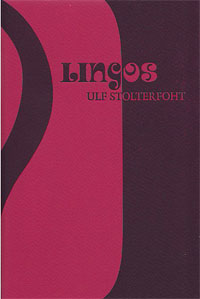
These fine points are everywhere on display in Cuneiform’s recent release of Lingos VI by German poet Ulf Stolterfoht. This chapbook is nothing less than gorgeous. Its thick, letter-pressed maroon cover acts as a dustjacket whose design is echoed in the interior of the chapbook, demonstrating Schlesinger’s masterful subtlety and care. “Ulf and I met while I was living in Berlin,” notes Schlesinger, “a city with a lush typographic history that you can see in everyday design practices.” For a printer, and especially one so steeped in his art, something as simple as a stroll around town can be dangerously time-consuming. “Maps, postcards, posters, magazines, and even the ticket stubs often stopped me in my tracks, full of awe and delight. Sometimes the waiters would come to the table and only then would I realize that I had been admiring the menu’s kerning [the spacing between letters] rather than thinking about what to eat!”
How could one hope to compete with, or at least complement, work produced in a city so amicably tied to design? “From Gutenberg to the Bauhaus to FontFont to the controversial history of Fraktur, Germany has been a center for printing and innovative design since the very beginning,” Schlesinger explains, “but oddly enough, I didn’t feel at all compelled to set Lingos VIin a German font.” Just as Rosmarie Waldrop brought into English Stolterfoht’s German verse, Schlesinger too opted to cross the Atlantic for a translation of sorts in the sense of design, settling on a font called Jojo, created by the Canadian company Canada Type. In a further sequence of translation, this font, which features ’60s-style psychedelic swoops and curls, takes its name from the lyrics of the Beatles’ song “Get Back.” “For the dust-jacket,” Schlesinger says, “I blew up the Roman Numerals VI to 500pt. to create an abstract background that would bleed off the page, then I positioned the title and author’s name so that some of the letters would drop out of the I’s stem (this motif was repeated in red on the title-page).” To the average reader, much of this information might seem unimportant, or otherwise remote, but it is exactly this sort of detail and attention that can, often unknowingly, ease one into the experience of a book.
And once one begins to actually read Lingos VI, the subtlety of the chapbook’s balanced design is immediately detonated, as Stolterfoht’s verse is exuberant and explosive; it allows phrases, lines, and sentences, by turns prosaic and condensed, to ignite in the mind an unsettled, combustible sense of language’s grip on the world, until it is as though these poems ask who, exactly, is holding whom? Stolterfoht has been working in the serial mode throughout his three books published in Germany. Each is given the title Fachsprachen—German for technical languages or jargon, and translated by Waldrop as Lingos. This chapbook presents the sixth sequence, itself comprised of nine poems, each of which features five four-line stanzas. The strictly regimented form gives way to loose rhyme, ghostly meter, and an always self-reflexive questioning. Each individual poem carries a title that includes the termmuttersprache (mothertongue), followed by a date, and phrase like “friend-foe-recognition” or “YO HERMENEUTICS! susan sontag declares war.” In the Author’s Note, Stolterfoht explains that these poems owe their titles to the linguistic journal muttersprache, and that “there are subtle relations between the poems and articles in the named issues.”
When I originally received a review copy of this chapbook, it included a note from Schlesinger calling the book “something of a teaser for the Burning Deck Lingos I-IX due out soon.” Although I’d eventually read that full-length version as well, I found myself compelled to return more often to the excerpt contained in this chapbook. Schlesinger, too, understands such compulsions, as he states, “as a reader I’m still very much in love with duration, that I can read a chapbook in a single sitting (usually) and I love the materiality.” Duration and materiality go a long way to explain the appeal of this chapbook. One feels welcomed, even as the work itself tends to unsettle, jar, and shock. After all, who hasn’t experienced an odd pain in one’s joints, followed by the inability to stop twisting toward the exact position that had originally brought on the sensation?
It’s hard to imagine a more impressive chapbook publishing venture than that of Atticus/Finch. Since its inception by publisher Michael Cross in 2003, the press has brought out a dozen chapbooks of extreme quality, featuring thick letter-pressed covers and dramatically different shapes and sizes. “I wanted to make books that did justice to the amount of effort that went into the poetry I was printing,” Cross explains. His keen eye and diligent craftsmanship does just that, as any title on his press offers one the multiple pleasures of intelligent poetry expressed via an exquisite design. The look, shape, and feel of an Atticus/Finch book offers nearly as much to ponder as the material one finds within it. Beginning by documenting the work of the New Brutalism, the now-defunct moniker for a specific moment of confluence in Bay Area poetry, Cross brought into the world books by Cynthia Sailers, Elizabeth Willis, Julian T. Brolaski, and Eli Drabman. Once Cross moved from the Bay Area to attend the Poetics Program at Buffalo, the output of his press began to reflect its vibrant community of past and present denizens, including books by Gregg Biglieri, Myung Mi Kim, Patrick Durgin, and a stellar collaboration between Thom Donovan and Kyle Schlesinger.
Although his creations might call for it, Cross is quick to dismiss the appellation of book artist: “I’ve never thought of myself as a book artist,” he notes, “instead, I wanted to make books that enforce the poems, so that the book’s form is simply an extension of its content (as Creeley would have it).” And here, one finds with each book what Cross calls “the spirit of collaboration at Buffalo.” After arriving in the blustery post-industrial town, he began an apprenticeship of sorts with Kyle Schlesinger, and subsequently helped to train other incoming students on the particulars of printing. “When the press is running,” he says, “the doors are open, and there are always a number of folks helping run or pull. This, of course, leads to any number of collaborations, from presses working together to produce a book to folks offering their services to sew.” Because of the labor-intensive process, these services are often indispensable. “Sometimes folks don’t get how much time and money goes into these books. In fact,” notes Cross, “I realized long ago that I would be saving money if I just made print-on-demand trade editions. But I wanted to make an object, something that worked on the senses at all levels.”
For Cross, this sense of an object is tied to the chapbook’s ability to arrest attention, to sculpt and freeze the present: “Atticus/Finch is a vehicle to print poems with some immediacy (cultural, political, etc.) in medias res. I wanted from the beginning to print books that were in conversation, in the air, while they were in conversation, in the air.” Doing such work has given Cross a window into one of the more intriguing aspects of the chapbook—its ability to alter the trajectory of an author’s future concerns. “It’s super instructive to study what happens when a chapbook finds a home in a full-length book,” he says. “One can learn a lot about a writer’s practice by tracking the difference.” These differences can be subtle or substantial; oftentimes, their subtlety is precisely what makes them substantial. When Wesleyan University Press published Elizabeth Willis’s Meteoric Flowers in 2006, for example, the poems from her Atticus/Finch chapbook of the same title reappeared in a dramatically different order, fundamentally altering a reader’s experience.
The mere act of printing itself can also affect one’s experience of a text. The more time Cross spent printing, the more he found himself enchanted with the act: “It’s pretty magical (or, I suppose, alchemical) to make the poem into an object, to actually sink the letters into the page. Your relationship to the poem changes. So much of our labor as poets is abstract—at the end of the day, when printing, you get to take something home with you.” That this something can encompass object and idea—the abstract mental sphere of the poem and the concrete earthiness of an object, an absolutely touchable, tangible book—gets to one of the core pleasures of chapbook culture: economies with little capitalistic commerce. “I guess it all comes down to a gift economy for me,” says Cross. “I have a personal relationship with each and every book I print, and I think of the labor of publishing as a gift to the author (and reader) that such a work exists!”

Cross’s latest chapbook to enter this gift economy is that of C. J. Martin’s Lo, Bittern, which carries the characteristic striking production of Atticus/Finch. Its cover is printed with black ink on sturdy pink cardstock with French flaps, and features a grid design with several repeating geometric shapes. The interior signature is hand sewn with black thread, which helps to echo the overall symmetry of the book’s design. The pink and black combined with its smaller size create a sort of physical tension; there is something uneasy about this chapbook’s elegance, which makes it ultimately all the more compelling. When settling on a look for each of his chapbooks, Cross often finds that “the poems themselves are responsible for so many of the design decisions.” Thus, one need look no further than the poems themselves to discover the officiator of such an off-kilter marriage of elegance and uncertainty.
Martin’s verse is difficult and arresting. Its difficulty is that of any encounter with difference—that which calls for a recalibration of whatever machinery one has erected in order to engage with a text. It is poetry that gives one pause, which I mean as the highest possible praise. Yes, there are familiar elements here: the spare yet constricting brevity of later Celan; the visual materiality of some of Susan Howe’s work; Leslie Scalapino’s use of duration as landscape; various techniques of collage, abbreviation, assemblage, sound-driven writing and referential uncertainty. However, it is Martin’s orchestration of these elements that makes them once again odd and strange. Like the occasional reflection of one’s own eyes in a pair of glasses, these poems negotiate the inevitable transaction of language by looking back at themselves while staring at the world. Which is to say that the poems are not at all lacking in subjectivity and content; rather, their subject seems to be a containment of the transitory aspects of language. We don’t get what happens; we get happening: “For when—and then as much as— / was at least something, / slowly. —Rigs it, blown.” Lo, Bittern is a chapbook worth hunting down and approaching with caution, as it might take off the top of your head.
What strikes me as wonderful and exciting about this particular group of chapbooks is that it is a company, it is a constellation—but one forever open to revision, to new formations. Several years ago, the forums at the website Foetry.com were a hotbed of anonymously scribed accusations, conspiracy theories, and generally vindictive, venomous quips regarding the state of publishing in contemporary American poetry. Within such a miasma of petty muckraking, the one moment of crystalline, articulate passion that stood out was Robert Creeley’s contribution. Over the course of several days, Creeley posted to these forums, his legendary sense of company brightening the otherwise murky atmosphere. Although these posts are no longer online, I have a vivid memory not of what, exactly, Creeley had written, but ofhow his writing seemed to nullify, gently, so many of the enraged and anonymous arguments circling around the topic of conflicts of interest. I remember reading these forums with the same sort of voyeuristic attraction and repulsion one feels after having stopped to watch the aftermath of an accident. But Creeley approached the debacle with care; anyone reading his posts could feel his deep conviction, and the sense that as poets, and publishers, one should honor one’s interests, and keep one’s company.
Rain Taxi Online Edition, Summer 2008 | © Rain Taxi, Inc. 2008

